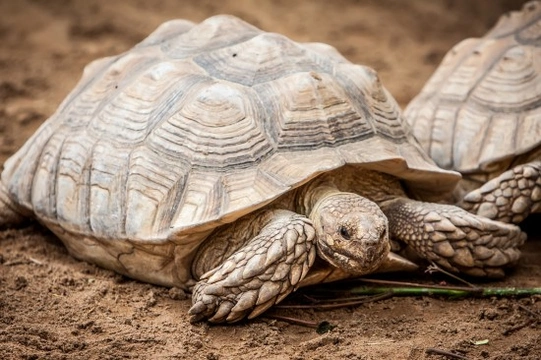
23 Fun Facts About Tortoises You Might Not Know
Tortoises are fascinating creatures, and despite their slow reputation, they can move quite quickly when needed. It's common for pet tortoises to find their way out of gardens before owners notice!
Amazing Facts About Tortoise Anatomy and Behaviour
- A tortoise's shell is composed of 60 connected bones.
- The top part of the shell is known as the carapace.
- The underside is called the plastron.
- A firm bridge connects the carapace and plastron.
- Tortoises can retract their heads, limbs, and tails into their shells for protection.
- They have strong mouths with no teeth but use horny beaks to chew their food.
- Their vision is good, and they also have an excellent sense of smell.
- Being cold-blooded, tortoises rely on environmental heat and are mostly active during daylight.
- Some can live over 150 years, with an average lifespan between 90 to 150 years.
- They are herbivores, eating grass, ferns, leaves, flowers, and fruit.
- Female tortoises tend to be larger than males and dig burrows to lay 1 to 30 eggs.
- Males can be identified by their longer tails.
- Baby tortoises, called hatchlings, incubate inside eggs for 90 to 120 days.
- Before hibernation, tortoises empty their stomachs through self-starvation to prepare for winter rest.
Fascinating Facts About Galapagos Giant Tortoises
The Galapagos Islands are home to unique giant tortoise species. Originally 15 species existed there, now reduced to 11. Each island hosts its own species with distinct traits.
- Saddleback tortoises have a notch in their neck to raise their heads and eat vegetation high above the ground.
- Domed shell tortoises favour grazing on low vegetation and grass.
- The oldest recorded giant tortoise lived to 152 years.
- They can grow up to 5 feet long and weigh more than 500 pounds (over 225 kg).
- In the 19th century, sailors hunted them as a fresh meat source on long voyages.
Giant tortoises are creatures of habit, often returning each year to the same spot to lay eggs. They can also survive for very long periods without food or water.
Additional Interesting Giant Tortoise Facts
- Their rigid shells prevent them from expanding their chests to breathe, so special muscles assist in respiration.
- Known scientifically as Geochelone Elephantopus.
- Natural predators include wild dogs, rats, cats, and pigs that threaten the eggs and hatchlings, while adults face risks mainly from humans.
- Tortoises belong to the family Testudinidae and order Testudines.
- They are distinguished from turtles as they live exclusively on land and lack flippers.
- The Leopard tortoise weighs 30 to 50 pounds and measures 15 to 18 inches long.
- Leopard tortoises can live up to 90 years and are herbivores like their giant cousins.
- Tortoises are susceptible to parasites and pneumonia, so health monitoring is essential.
- Healthy tortoises have clear, bright eyes and show no discharge.
- Use two hands to hold a tortoise, providing firm support underneath to reduce stress from feeling air beneath them.
- About 40 tortoise species exist worldwide.
- Aesop's famous fable "The Hare and the Tortoise" celebrates their slow but steady nature.
- Some of the most endangered species include the Yellow-footed, Brazilian Giant, Forest, and South American tortoises.
Responsible Tortoise Ownership
Keeping tortoises as pets can be rewarding, especially for families with children. Their long lifespan means commitment is essential. Always research the specific species you consider and prepare a habitat with proper lighting that replicates natural sunlight to prevent health problems.
Hibernation is a vital part of a tortoise's life cycle. Learn about correctly managing this period and avoid disturbing your tortoise during hibernation to ensure their wellbeing.
Consider adopting from rescue centres or trusts to give a tortoise a second chance, promoting ethical and responsible pet ownership.
Additional Fascinating Tortoise Facts
- Galapagos Giant Tortoises are the largest in the world, measuring up to 5 feet and weighing over 225 kilograms.
- They lack teeth but use sharp edges of their mouths and powerful jaws to consume tough vegetation.
- Tortoises cannot swim but are able to hold their breath underwater temporarily and are highly tolerant to carbon dioxide.
- Their digestive system separates water from waste to conserve moisture during dry spells.
- Tortoises "smell with their throats" using a special organ called Jacobson's organ, pumping the throat to detect scents in the air.
- Some tortoises demonstrate remarkable intelligence, capable of memorising and navigating mazes and recognising human faces.
- The Roman testudo military formation was inspired by their protective shells.
- In history, sailors relied on tortoises as a source of fresh meat on lengthy sea voyages.
- Tortoises have even been part of space exploration, with Soviet tortoises orbiting the Moon in 1968 and surviving the journey.
- The smallest tortoise species, the Speckled Tortoise of Southern Africa, weighs under 120 grams.
- Tortoises have nerve endings under their shells and can feel touch, so handle gently.



